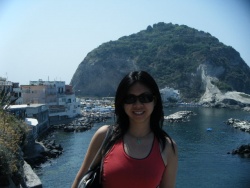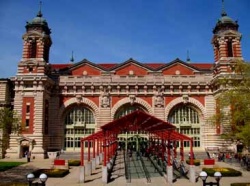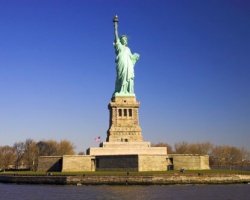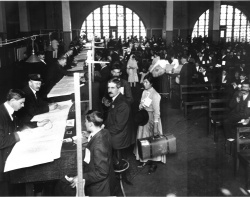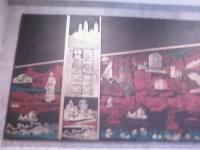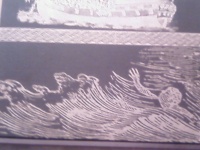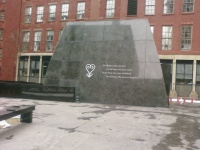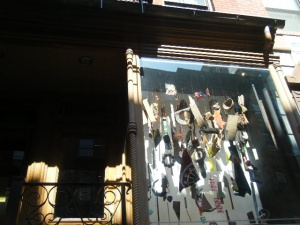From The Peopling of New York City
Contents |
Rolanda
About Me
My name is Rolanda Tseo. I am a student in the Macaulay Honors Program at Baruch College. I am pursuing my degree in either Business Management of Entrepreneurship. I always knew that I wanted to attend a university that is in a city and Baruch seems to be a pretty good fit, so far. If I had not decided to attend a business school I would likely be at a Culinary school. My dream job is actually to be a chef and to maybe own my own restaurant. A love for food runs in my family and it is an interest that we all share. I am very fortunate that my family supports me in everything that I do. My mother has never tried to impose her vision for my future upon me. She has always told me to do what makes me happy.
I am a only child and I live with my mother in New Jersey. I was born in Flushing, Queens and lived for a few years in Jackson Heights before moving to a town in New Jersey called Berkeley Heights. I have lived in New Jersey for most of my life and despite the reputation that it has, it really is a very comfortable and pleasant place to live. Much of my family is still in Queens and I visit there often.
I am in an amazing organization at school called AIESEC. I am very passionate about it and without it I am pretty sure that my college experience would be a lot less rewarding. This organization is the largest student run, non-profit organization in the world. There are members around the world all trying to make the world a better place. AIESEC has taken me to a lot of fun cities and allowed me to meet a lot of inspirational and interesting people. The people in AIESEC are like a family to me now and I know that they are the ones that really are going to make a difference in the world.
My Ideal Community
There are many ideas of what the ideal community is. In my ideal community all the people would be like-minded and they would not persecute people for having differing opinions or ideas. I think that this is one of the most important things for an ideal community. Understanding of others will allow people to be able to work together more efficiently and they will be able to make decisions together. All the people would work towards the good of the entire community and not for selfish reasons. I think one of the major problems of today’s society is that people are always trying to out-do each other. This whole “keeping up with the Joneses” mentality has been fairly detrimental thus far. They do not realize what is truly important is to work together.
Doctors would actually work to help people and not just to make money. Pharmaceutical companies would not be businesses but rather charitable or non-for-profit organizations. Today, it seems as though they exploit people, more and more medications are coming out and pharmaceutical companies manage to convince people that they need these new medications. People would be conscious of the environment and there would be minimal pollution and squander of natural resources. It is very important for all of the members of the society to realize that things that they do really will affect all of the members of society. All members of society and there would be no one left jobless or on the streets. This society sounds very similar to a socialist community, and on paper this seems very attractive to most and also like a sort of fool-proof plan, but as history has shown this society could never really succeed. While in reality this community could never exist because of the flaws of the human race, it is, for me what and ideal community would be like.
Immigration Film Clip
This is a clip from the film "Maria Full of Grace". It is in Spanish but, the main point of this clip is that the main character, Maria, is now in the United States with another girl that was also a drug mule is with her and they go to see "Don Fernando". It is difficult to really get the meaning of the clip without having the full background of the film but, when you see Maria walking through the streets of New York, she is contemplating what she will do and thinking about her family back home. She sees things that remind her of home and also she sees hope and opportunity. She decides, ultimately, to stay and raise her unborn child in New York. It shows how immigrants feel when they come here, after seeing complete poverty and no social mobility in their home country.
From There to Here
I am a first generation Chinese. Both of my parents lived comfortable lives back in their countries of origin. They were very lucky, in that they did not need to struggle or sacrifice very much to come to this country. My mother immigrated here from Hong Kong when it was still under British control. She came here, following in the footsteps of her two older brothers, to seek a college education. Ironically enough, she attended Baruch College. Soon to follow her was her younger sister and brother, and before long the whole family had relocated to the NY area, mostly in Queens.
My father was from Mainland China until the communist takeover. Being as my great-grandfather was a government official, the family had to flee to Taiwan. By this time my father was in high school and only spent a few years in Taiwan before immigrating to the United States for graduate school. He attended Oklahoma University, where he received his masters in English. My father then moved to New York, where his other siblings had also relocated to. Later on, much of his siblings settled in New Jersey. While he was in New York visiting his family for the holidays he met my mother. They got married and bought a house in Jackson Heights. They then moved around the New York/New Jersey area. My mother worked in Manhattan while my father worked in the New York area in real estate and also running a restaurant. Between all of this I was born in Flushing, NY. We continued to live in Jackson Heights until my mother's job brought us to the house where my mother and I still reside.
During my childhood, we spent much time going back and forth to New York to visit family. My grandmother was living with my mother's sister in Flushing and we spent many weekends there, where I was exposed to more traditional Asian culture. My grandmother showed my cousins and me all of the best that Flushing had to offer. We ate out so often that my grandmother almost always had a table waiting for her, no matter what restaurant we went to. This love for food is a common thread on both sides of my family. I learned to speak the languages of my culture; both Cantonese and Mandarin. I walked through the streets of Flushing, in amazement of all the different shops and food stands that were basically non-existent in my neighborhood.It was so different from the area in which I lived. There are very few Asian families in the town that I live in and it wasn't until maybe 10 years ago that the first Asian food market opened a few towns away. A few years ago my father passed away Today, my family is still very centrally located in this area, although some of my cousins have branched out to Boston, Hawaii and even back to Hong Kong.
Neighborhood Census
Berkeley Height Census Information
My town is predominantly white, as statistics will show. It is very evident, there is a very small percentage of minority population. Out of the 13,000 people that live in the town, over 12,000 are white. I believe that the lack of diversity is one of the town's major drawbacks. Without exposure to other cultures I think that it causes people to be more close minded.
All of the statistics are pretty much on point with what one would actually see in my town; the average income, the population, and ethnicity breakdowns etc. The only thing that did not really match up was the average price of houses. The average costs are approximately $250,000 but in the neighborhood in which I am located, the average price is nearly 4 times this amount. Overall, with the generally high income, I was surprised at how much homes cost in the other areas of town.
Class Notes
6 February 2009
-What is our idea of an ideal community? -General themes - equality, less pollution, acceptance of others, health.
GROUP 1: - Peaceful interaction - Acceptance of others - Clean transportation
GROUP 2: - Diversity - Respect for others - Self-sufficient - Environmentally conscious
GROUP 3: - care about each other - not concerned with materialism - work toward common goals - healthy
13 February 2009
Migration to New York: Push/Pull Factors
Pull Factors: drew people to NY because of the benefits - Economic opportunities - Resources - Diversity - Shopping - Climate
Push Factors: drove away from their homelands because of negative experiences - War - Religious persecution - Economic turmoil - Political unrest
20 February 2009
General Theme for Class
How are immigrants to NYC (American in general) visually (and otherwise) represented in history, sociology, journalism, art, movies, television, museums, etc?
Viewing of immigration related film clips Group Analysis - 5 commonalities that the films show about immigrants 1. Push factors 2. Social status changes 3. High expectations 4. Sense of family 5. Difficulty coming here
27 February 2009
Ellis Island visit
6 March 2009
African Burial Ground visit
13 March 2009
Class Wiki Project- section sign-ups
OVERVIEW: - Introduction - Summary - Bios - Anna, Christian, Emily, Vincent
NATIONAL PARK SERVICE: - Ellis Island - Yura - Castle Clinton - Alice - African Burial Ground - Margot - Tenement museum - Rolanda
RESEARCH: - Census tracts - Books/readings - Alisa, Andrew, Duke
MEDIA/TECH: - Film clips/ movies - Videos/Photos - Music - Andrey, Daniel, Jasper
METHODS: Design, Visual (video, photography), Text/Editing, Audio
20 March 2009
ASSIMILATION: - Other cultures absorb American society and dissolve into it - American society is a melting pot of all the different cultures that came to the US - W.A.S.P. --> White Anglo-Saxon Protestant - Those who do not wish to conform are viewed negatively by the general public Ex: Why don't immigrants learn English? etc. - Berger
STEW POT: - Adjust to American society but still hold on to some of their own traditions – cultural pluralism - Emphasizes differences in cultures - Most realistic in our society
SALAD BOWL: - People who retain their own culture – multiculturalism - Emphasizes the commonality between cultures - Foner
3 April 2009
Mid-term Examination
24 April 2009
Lower East Side Tenement Museum visit
1 May 2009
Delegating Wiki tasks
8 May 2009
Editing Wiki project with Craig
Ellis Island
National Park Service | Ellis Island
Ellis Island was the center in which immigrants would be "processed" before being allowed entry into America. Countless immigrants passed through the gates of Ellis Island hoping for a new hope and a better life for their families. Once people passed through here, many would never return to their homelands again.
African Burial Ground
National Park Service | African Burial Ground
The widely unknown story of this landmark was discovered. A short film introduced us to the Memorial and gave a short history of how it was found and how it was excavated and studied. Following this, we began our tour through the main building. Here, we viewed the vast artwork that was displayed throughout the building that was dedicated to the forgotten people that were buried there. Some of the artists that had contributed pieces included: Joseph Depace, Estella Conwill, Houston Conwill, Barbara Chase-Riboud, and Tomie Arai. The pieces of art seemed to document the story, and the progression of the African people's journey to New York. We then proceeded to view the outdoor memorial located behind the building, known as the Ancestral Libation Chamber.
Lower East Side Tenement Museum
Lower East Side Tenement Museum | Home
National Park Service | LES Tenement
In this building we saw the living conditions of families such as the Irish, Moores, and the German, Katz, once resided. Not only were the typical lives of a family highlighted but the story of these individual families was shared with us. Some of the rooms in the building had been restored to convey what the apartment probably would have looked like during the time that these families had actually lived there. It was very interesting that the stories were actually relayed to the museum from direct descendants of the families that once inhabited those apartments. Interesting facts about "swill milk", Tammany Hall, and Irish music were also discussed.
Midterm
Midterm Questions:
1. What were the similarities and differences between the three books in terms of style, theme and information?
2. Using the three books as references, describe which ideology you think is occurring today?
3. Describe, discuss & give examples of assimilation in each of the three books.
Theories and ideologies of immigrant adjustment to American society:
America is known as a “melting pot” there is this notion put to the world that this is a place in which many cultures meld together to create what is known as being American. However, there are two very different views in regards to the assimilation of immigrants to American society. There are ideas that immigrants should still keep close ties to their cultures and cherish their heritage, while others believe that once they come to America they should be completely Americanized. Many times you hear “Americans” complaining about the immigrants that come here, claiming that they should “learn how to speak English” or “stop taking our jobs” but, it is almost guaranteed that these people all are descendants of immigrants and most of them probably have grandparents or even parents that don’t speak perfect English. Nancy Foner mentions in her book, “From Ellis Island to JFK”, “Because most immigrants are from relatively poor and developing nations does not mean, as many Americans believe, that the immigrants themselves are uniformly poor and uneducated…significant numbers of the newest New Yorkers enter with college degrees and technical expertise.” So contrary to the belief of many Americans, these immigrants are not uneducated.
Another view on immigrants are that they should continue to identify with their cultures. It is the opinion of many that if they completely assimilate to American culture, they will lose their cultural identity and that it will not be passed on to their children. This idea is evident in Nathan Glazer and Daniel P. Moynihan’s Beyond the Melting Pot. They call this cultural pluralism. This idea holds that the families should only assimilate to a certain extent but continue to identify with their roots. A more extreme version of this is noted in Nancy Foner's From Ellis Island to JFK. She talks about multiculturalism, which is, essentially, the idea that immigrants should focus on identifying with their culture and not worry too much about assimilation. As the newer generations start having children the cultural ties grow weaker and weaker, unless the children are really instilled with a strong sense of where they came from. However, these families, that have strong cultural values, are considered to be very conservative or living in the past, but, this is certainly not the case.
One group that had a uniquely difficult time adjusting was the West Indians. Because they were “black” they were expected by the black community to assimilate with them, however, their cultures are not the same and Foner noted that “West Indian students – as blacks – experience pressure in the local schools to be black American, which often means adopting an oppositional identity that sees doing well academically as ‘acting white.’” But, this was contrary to their parent’s hopes for them. They wanted their children to do well academically, but pressure from their peers to assimilate ultimately caused them to oppose academics.
If people really think about America and it’s origins they will come to see that there really is no such thing as being “American”. The American culture is simply borrowed elements of many other cultures. We were not the first people here and to say that others coming here to live are not becoming “American” is hypocritical and wrong. There is nothing wrong with identifying with your own heritage and being proud of where you hail from. People from all over the world can adjust to the society here and still call themselves American, but their cultural ties is what makes them unique. This unique tie to two different cultures is what I think it means to be truly American. The fact that Americans can say that they are American and also, that they identify with another group that they are also proud to be a part of is what American culture is truly about.
What’s happening today? Theories and ideologies
Today in the United States, ethnic groups that are arriving in large numbers are continuing to identify with their cultural backgrounds. There are more ethnic neighborhoods than ever. They bring their food, their languages, and their customs with them. There are so many unique aspects of this phenomenon. Because the ethnic groups are so proud of where they come from, sometimes tensions can build between rival groups. This can sometimes lead to crime and violence for dominance in certain areas. When one ventures out into neighborhoods such as Chinatown, Brighton Beach, and Greenpoint, one can see the cultural identity of the area almost immediately. The people there speak their native languages and they eat their native foods. Many of the store signs are in different languages or have multiple languages.
For many, they say it is just like being “home”. When immigrants are in the mood for feeling nostalgic, they can go and visit these little displaced pieces of their countries. Additionally, this adds to the interest of a city, especially in the case of New York, where there are so man different ethnic groups represented. The fact that each group has a certain area that they can call their own and practice their own cultural traditions amongst people with similar backgrounds is something very unique about the city. Joseph Berger’s The World in a City discusses the constantly changing faces of different neighborhoods of New York. Two ever changing neighborhoods that are highlighted are Douglaston, in Queens, and East Harlem in Manhattan. He discusses the influx of Asians in Douglaston and the change from mostly Italian to mostly Hispanic in East Harlem. They are very different neighborhoods, yet have experience similar situations in the way of drastic change.
In addition, the groups of people that are coming to New York today are a much wider variety of people. There are more and more groups finding their own niche in New York. Nancy Foner mentions, “There are immigrants like Pradip Menon, born into a wealthy professional family in Poona, India, who arrived in New York with a college degree in engineering from a prestigious university and an M.B.A. from an equally prestigious management school. And there are those like Benjamin Velasquez, a poor farmer in El Salvador who worked on his family’s parcel of land growing corn and beans”. The difference between the types of immigrants that are coming in is much different from the immigrants that were coming before. No longer are people just trying to escape oppressive governments or famine but educated people are coming here to make their livings as well.
The numbers of certain groups such as, Indians, Puerto Ricans, and Dominicans, have been steadily rising over the years and their percentage of the population of New York has risen noticeably. Additionally previous bans and restrictions on immigration have allowed for certain groups to resume immigration to this country. “Changes in U.S. immigration policy have affected the magnitude and shape of the latest wave; they have also altered the immigration process itself.”
